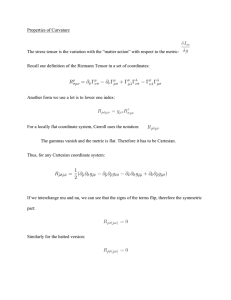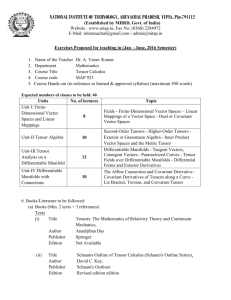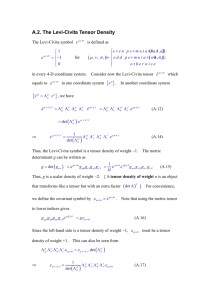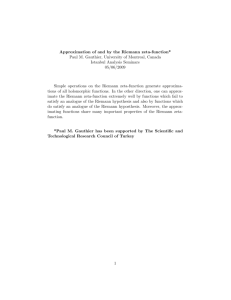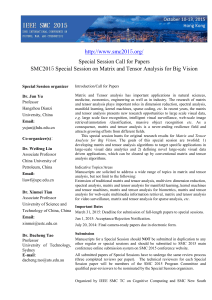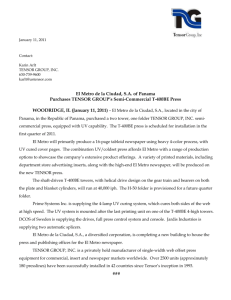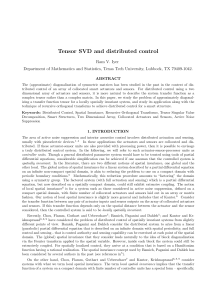1 S. A. Fulling C. J. Cummins GROUP-THEORETICAL CLASSIFICATION
advertisement
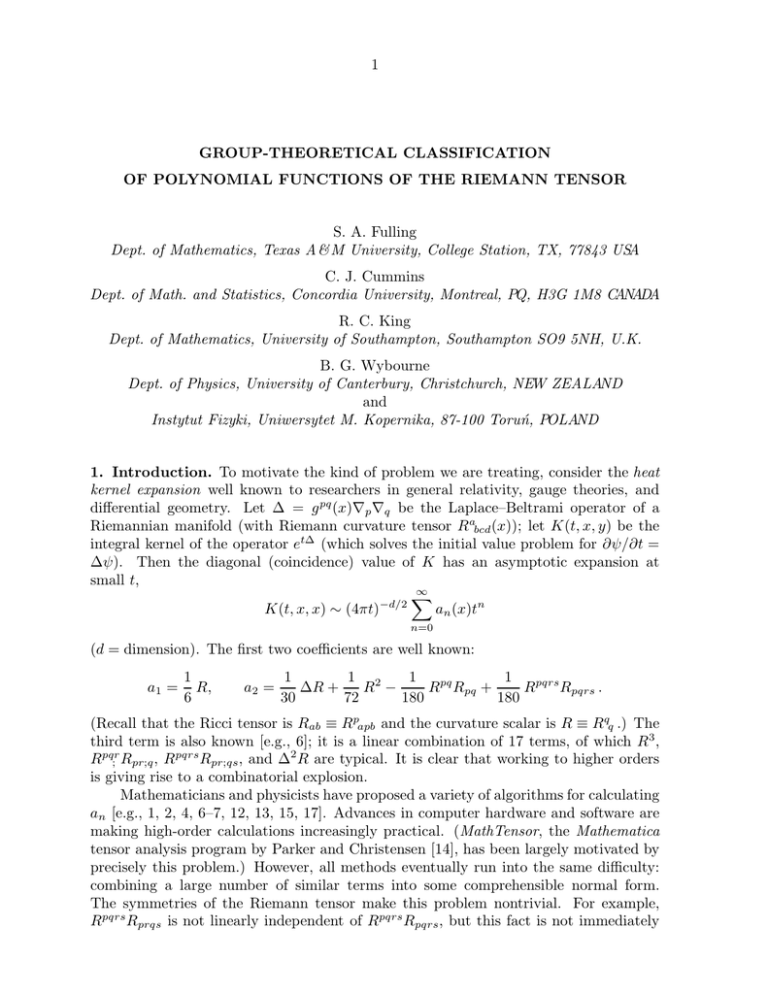
1
GROUP-THEORETICAL CLASSIFICATION
OF POLYNOMIAL FUNCTIONS OF THE RIEMANN TENSOR
S. A. Fulling
Dept. of Mathematics, Texas A &M University, College Station, TX, 77843 USA
C. J. Cummins
Dept. of Math. and Statistics, Concordia University, Montreal, PQ, H3G 1M8 CANADA
R. C. King
Dept. of Mathematics, University of Southampton, Southampton SO9 5NH, U.K.
B. G. Wybourne
Dept. of Physics, University of Canterbury, Christchurch, NEW ZEALAND
and
Instytut Fizyki, Uniwersytet M. Kopernika, 87-100 Toruń, POLAND
1. Introduction. To motivate the kind of problem we are treating, consider the heat
kernel expansion well known to researchers in general relativity, gauge theories, and
differential geometry. Let ∆ = g pq (x)∇p ∇q be the Laplace–Beltrami operator of a
Riemannian manifold (with Riemann curvature tensor Rabcd (x)); let K(t, x, y) be the
integral kernel of the operator et∆ (which solves the initial value problem for ∂ψ/∂t =
∆ψ). Then the diagonal (coincidence) value of K has an asymptotic expansion at
small t,
∞
X
−d/2
K(t, x, x) ∼ (4πt)
an (x)tn
n=0
(d = dimension). The first two coefficients are well known:
a1 =
1
R,
6
a2 =
1 2
1
1
1
∆R +
R −
Rpq Rpq +
Rpqrs Rpqrs .
30
72
180
180
(Recall that the Ricci tensor is Rab ≡ Rpapb and the curvature scalar is R ≡ Rqq .) The
third term is also known [e.g., 6]; it is a linear combination of 17 terms, of which R3 ,
Rpq;r Rpr;q , Rpqrs Rpr;qs , and ∆2 R are typical. It is clear that working to higher orders
is giving rise to a combinatorial explosion.
Mathematicians and physicists have proposed a variety of algorithms for calculating
an [e.g., 1, 2, 4, 6–7, 12, 13, 15, 17]. Advances in computer hardware and software are
making high-order calculations increasingly practical. (MathTensor, the Mathematica
tensor analysis program by Parker and Christensen [14], has been largely motivated by
precisely this problem.) However, all methods eventually run into the same difficulty:
combining a large number of similar terms into some comprehensible normal form.
The symmetries of the Riemann tensor make this problem nontrivial. For example,
Rpqrs Rprqs is not linearly independent of Rpqrs Rpqrs , but this fact is not immediately
2
obvious from consideration of the index symmetries of each factor separately. A different
kind of example is provided by Rpq Rqr Rrs Rsp — the trace of the fourth power of the
Ricci tensor, regarded as a matrix. By a well known theorem of matrix theory, it is
expressible as a polynomial in the lower-degree traces if d < 4.
Recognizing all such relationships, general and dimension-dependent, is a problem
in group representation theory. The groups involved are Sn (the permutations of a
tensor’s indices), GL(d), and O(d). The methods required are known to physicists
using group theory in atomic and nuclear physics [e.g., 18]. The lore is that associated
with Young diagrams; indeed, the Young diagram representing the symmetries of Rabcd
is the one with 4 blocks arranged in a square.
2. The basis problem for Riemann polynomials. Let us make the problem more
precise with some formal definitions:
A Riemann monomial is an expression formed by tensor products and contractions
from the Riemann tensor R and its covariant derivatives. A Riemann polynomial is
a linear combination of these. (Actually, because of the rule relating commutation of
covariant derivatives to R, we should work with cosets modulo terms of lower order and
higher degree.)
Let Rrs,q be the vector space of Riemann polynomials of rank r (number of free
tensor indices), degree q (number of factors R), and order s (number of derivatives of
g = number ofL
covariant derivatives plus twice q). Note that the heat kernel coefficient
n
an belongs to q=1 R02n,q . We can further subdivide according to how the covariant
derivatives are distributed among the factors; for example, R06,2 = R0{2 0} ⊕R0{1 1} , where
Rpqrs Rpr;qs belongs to the first of these sets and Rpq;r Rpr;q to the second.
We can now state three increasingly ambitious versions of our problem: For Rrs,q ,
(1) Find its dimension — the number of elements in a basis.
(2) Construct such a basis — list its elements. We want to choose the best basis — it
should be “natural” or “simplest” or . . . .
(3) Provide a normal form algorithm — i.e., tell how to express an arbitrary element
in terms of the basis.
In view of the nonuniqueness of the basis, one might add a fourth objective:
(4) Provide formulas or computer programs to convert from one basis to another.
3. Tools. The concepts employed include irreducible representation, outer product,
plethysm, branching rules, modification rules [3, 8, 9–11, 16, 18]. (Since there is no
space here for a course in group representation theory, we can only cite the jargon.) A
major tool is the computer program SCHUR written by Wybourne and his students [19].
4. Results so far [5]. On objective (1): SCHUR easily provides us with the number of
scalars through order 12. For example, in order 6 one gets the table
3
class
2
3
4
5
6
total
R06,1
1
R0{2 0}
1
2
1
4
R0{1 1}
1
2
1
4
R06,3
1
2
3
1
1
8
Total
4
6
5
1
1
17
1
where the column heading is the minimal dimension in which the object is independent
of simpler ones. We find 92 scalars in order 8 (cf. [1]), 668 in order 10, and 6721 in
order 12. (Since order is related to dimension in applications of an , these last are
potentially relevant to Kaluza–Klein and string theories.)
On objective (2): We have lists of all the scalars through order 8 and all the higher
rank tensors through order 6. For example, the table for R55,2 reads
tensor
representation
dimension
Rab Rcd;e
[5]+2[4 1]+2[3 2]+[3 12 ]+[22 1]
30
R;a Rbcde
[3 2]+[22 1]
10
RRabcd;e
[3 2]
5
Rpa;b Rpcde
[4 1]+2[3 2]+2[3 12 ]+2[22 1]+[2 13 ]
40
Rab;p Rpcde
[4 1]+[3 2]+[3 12 ]+[22 1]
20
Rpa Rpbcd;e
[4 1]+2[3 2]+[3 12 ]+[22 1]
25
Rpqab Rpqcd;e
[4 1]+[3 2]+[3 12 ]+[22 1]
20
Rpaqb Rpcqd;e
[5]+[4 1]+2[3 2]+[3 12 ]+[22 1]+[2 13 ]
30
The dimension stated is the number of independent index permutations, and the decomposition of the corresponding S5 and O(d) representation into irreducibles is given.
Objectives (3) and (4) are implicit in the foregoing results, but not yet realized in
practice. Their proper embodiment is in computer software, not a published document.
The methods shown here can be applied to problems involving other tensors in
addition to R.
4
References
1. P. Amsterdamski, A. L. Berkin, and D. J. O’Connor, b8 “Hamidew” coefficient for
a scalar field, Class. Quantum Grav. 6, 1981–1991 (1989).
2. I. G. Avramidi, A covariant technique for the calculation of the one-loop effective
action, Nucl. Phys. B 355, 712–754 (1991).
3. G. R. E. Black, R. C. King, and B. G Wybourne, Kronecker products for compact
semisimple Lie groups, J. Phys. A 16, 1555–1589 (1983).
4. B. S. DeWitt, The Dynamical Theory of Groups and Fields, Gordon and Breach,
New York, 1965.
5. S. A. Fulling, C. J. Cummins, R. C. King, and B. G. Wybourne, Normal forms for
tensor polynomials. I. The Riemann tensor, to appear.
6. P. B. Gilkey, The spectral geometry of a Riemannian manifold, J. Diff. Geom. 10,
601–618 (1975).
7. P. B. Gilkey, Recursion relations and the asymptotic behavior of the eigenvalues of
the Laplacian, Compos. Math. 38, 201–240 (1979).
8. R. C. King, Branching rules for classical Lie groups using tensor and spinor methods, J. Phys. A 8, 429–449 (1975).
9. D. E. Littlewood, Invariant theory, tensors and group characters, Phil. Transac.
Roy. Soc. (London) A 239, 305–365 (1944).
10. D. E. Littlewood, On invariant theory under restricted groups, Phil. Transac. Roy.
Soc. (London) A 239, 387–417 (1944).
11. D. E. Littlewood, The Theory of Group Characters and Matrix Representations of
Groups, 2nd ed., Clarendon Press, Oxford, 1950.
12. S. Minakshisundaram and Å. Pleijel, Some properties of the eigenfunctions of the
Laplace-operator on Riemannian manifolds, Canad. J. Math. 1, 242–256 (1949).
13. R. I. Nepomechie, Calculating heat kernels, Phys. Rev. D 31, 3291–3292 (1985).
14. L. Parker and S. M. Christensen, MathTensor: A System for Doing Tensor Analysis
by Computer, MathSolutions, Inc., Chapel Hill, N.C., 1991.
15. R. T. Seeley, Complex powers of an elliptic operator, Singular Integrals (Proc.
Sympos. Pure Math. 10), American Mathematical Society, Providence, R.I., 1967,
pp. 288–307.
16. H. Weyl, The Classical Groups, Princeton University Press, Princeton, 1939.
17. H. Widom, A complete symbolic calculus for pseudodifferential operators, Bull. Sci.
Math. 104, 19–63 (1980).
18. B. G. Wybourne, Symmetry Principles and Atomic Spectroscopy, Wiley, New York,
1970.
19. [B. G. Wybourne and others], SCHUR: An Interactive Programme for Calculating
Properties of Lie Groups, SCHUR Software Associates, Christchurch, N.Z., 1988.

